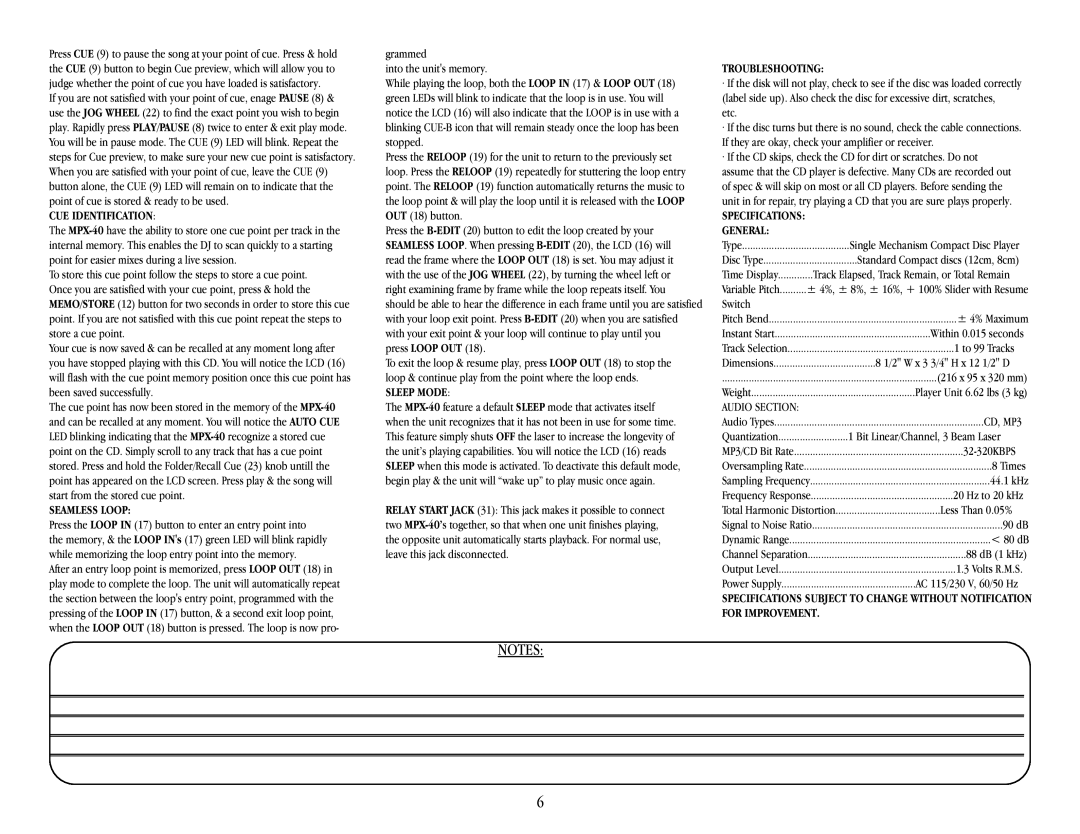
Press CUE (9) to pause the song at your point of cue. Press & hold the CUE (9) button to begin Cue preview, which will allow you to judge whether the point of cue you have loaded is satisfactory.
If you are not satisfied with your point of cue, enage PAUSE (8) & use the JOG WHEEL (22) to find the exact point you wish to begin play. Rapidly press PLAY/PAUSE (8) twice to enter & exit play mode. You will be in pause mode. The CUE (9) LED will blink. Repeat the steps for Cue preview, to make sure your new cue point is satisfactory. When you are satisfied with your point of cue, leave the CUE (9) button alone, the CUE (9) LED will remain on to indicate that the point of cue is stored & ready to be used.
CUE IDENTIFICATION:
The
Tostore this cue point follow the steps to store a cue point. Once you are satisfied with your cue point, press & hold the MEMO/STORE (12) button for two seconds in order to store this cue point. If you are not satisfied with this cue point repeat the steps to store a cue point.
Your cue is now saved & can be recalled at any moment long after you have stopped playing with this CD. You will notice the LCD (16) will flash with the cue point memory position once this cue point has been saved successfully.
The cue point has now been stored in the memory of the
SEAMLESS LOOP:
Press the LOOP IN (17) button to enter an entry point into
the memory, & the LOOP IN's (17) green LED will blink rapidly while memorizing the loop entry point into the memory.
After an entry loop point is memorized, press LOOP OUT (18) in play mode to complete the loop. The unit will automatically repeat the section between the loop's entry point, programmed with the pressing of the LOOP IN (17) button, & a second exit loop point, when the LOOP OUT (18) button is pressed. The loop is now pro-
grammed
into the unit's memory.
While playing the loop, both the LOOP IN (17) & LOOP OUT (18) green LEDs will blink to indicate that the loop is in use. You will notice the LCD (16) will also indicate that the LOOP is in use with a blinking
Press the RELOOP (19) for the unit to return to the previously set loop. Press the RELOOP (19) repeatedly for stuttering the loop entry point. The RELOOP (19) function automatically returns the music to the loop point & will play the loop until it is released with the LOOP OUT (18) button.
Press the
press LOOP OUT (18).
Toexit the loop & resume play, press LOOP OUT (18) to stop the loop & continue play from the point where the loop ends.
SLEEP MODE:
The
RELAY START JACK (31): This jack makes it possible to connect two
TROUBLESHOOTING:
·If the disk will not play, check to see if the disc was loaded correctly (label side up). Also check the disc for excessive dirt, scratches,
etc.
·If the disc turns but there is no sound, check the cable connections. If they are okay, check your amplifier or receiver.
·If the CD skips, check the CD for dirt or scratches. Do not
assume that the CD player is defective. Many CDs are recorded out of spec & will skip on most or all CD players. Before sending the unit in for repair, try playing a CD that you are sure plays properly.
SPECIFICATIONS: |
|
|
GENERAL: |
|
|
Type | Single Mechanism Compact Disc Player | |
Disc Type | Standard Compact discs (12cm, 8cm) | |
Time Display | Track Elapsed, Track Remain, or TotalRemain | |
Variable Pitch | ± 4%, ± 8%, ± 16%, + 100% Slider with Resume | |
Switch |
|
|
Pitch Bend | ± 4% Maximum | |
Instant Start | Within 0.015 seconds | |
Track Selection | 1 to 99 Tracks | |
Dimensions | 8 1/2" W x 3 3/4" H x 12 1/2" D | |
................................................................................ | (216 x 95 x 320 mm) | |
Weight | Player Unit 6.62 lbs (3 kg) | |
AUDIO SECTION: |
|
|
Audio Types | CD, MP3 | |
Quantization | 1 Bit Linear/Channel, 3 Beam Laser | |
MP3/CD Bit Rate | ||
Oversampling Rate | 8 Times | |
Sampling Frequency | 44.1 kHz | |
Frequency Response | 20 Hz to 20 kHz | |
Total Harmonic Distortion | Less Than 0.05% | |
Signal to Noise Ratio | 90 dB | |
Dynamic Range | < 80 dB | |
Channel Separation | 88 dB (1 kHz) | |
Output Level | 1.3 Volts R.M.S. | |
Power Supply | AC 115/230 V, 60/50 Hz | |
SPECIFICATIONS SUBJECT TO CHANGE WITHOUT NOTIFICATION FOR IMPROVEMENT.
NOTES:
_______________________________________________________________________________________________________________________
_______________________________________________________________________________________________________________________
_______________________________________________________________________________________________________________________
_______________________________________________________________________________________________________________________
6
